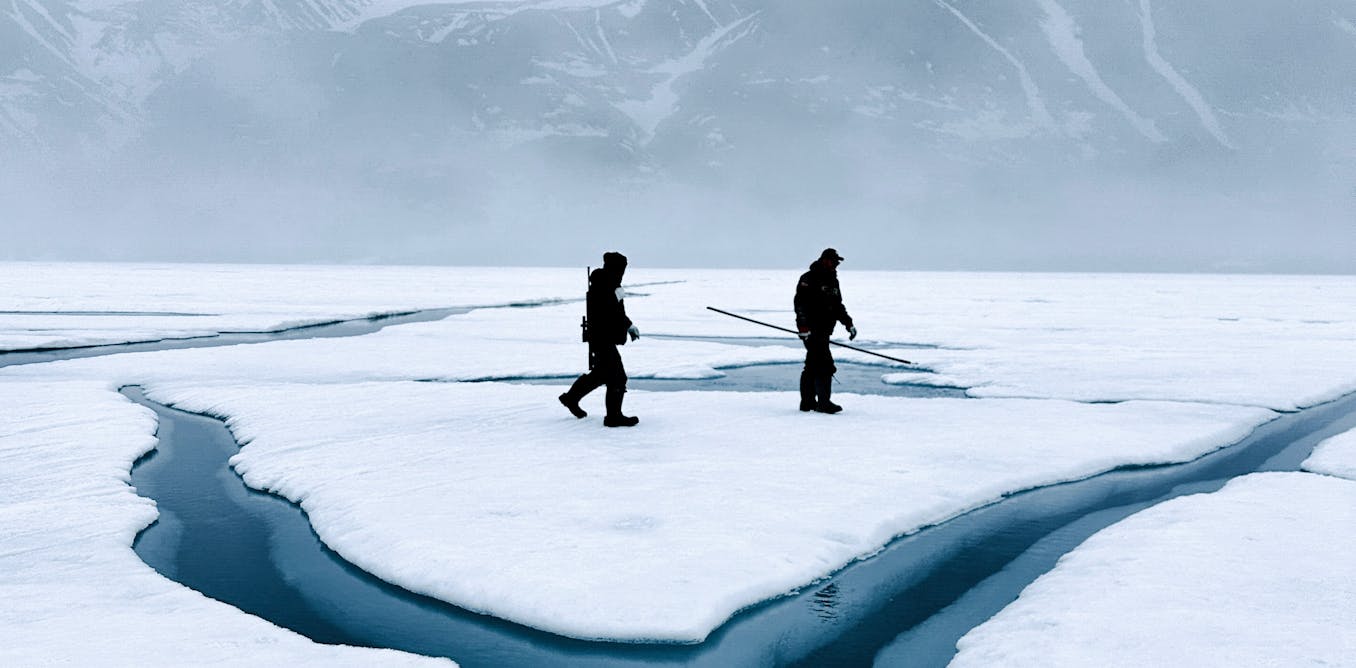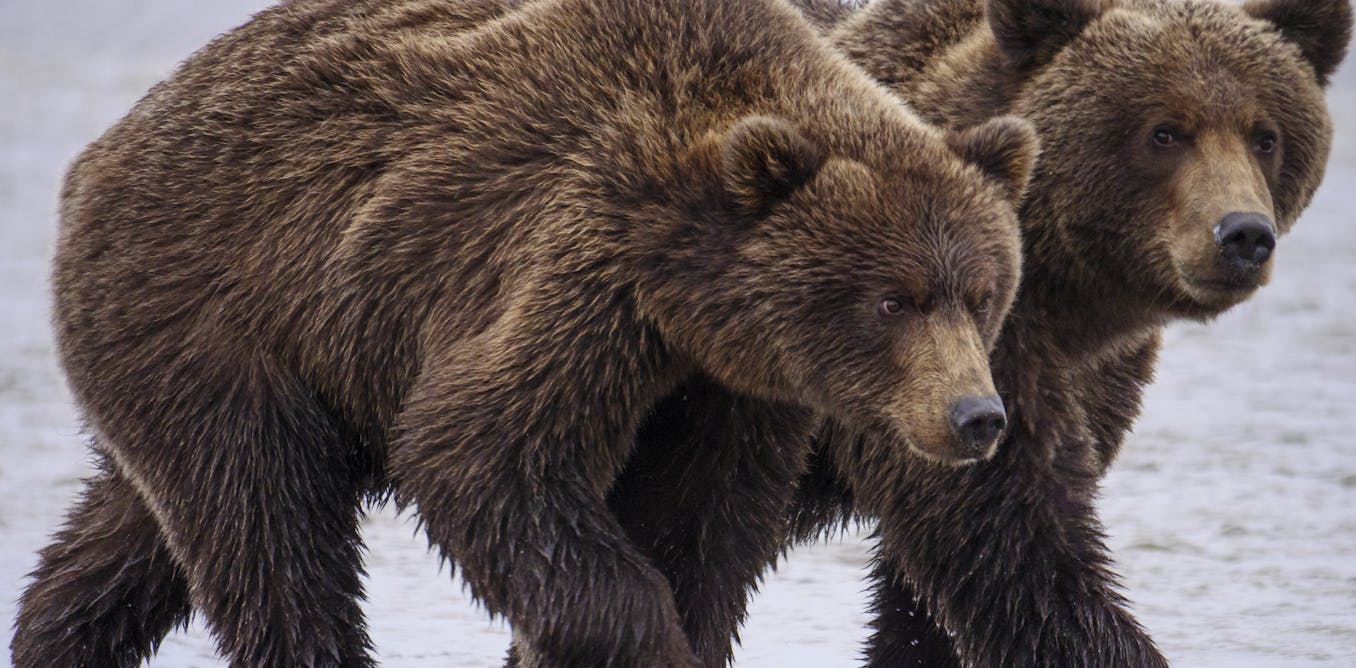The video titled “What Russia Discovered In Antarctica SCARES The Whole World!” delves into the intriguing and mysterious secrets hidden beneath the icy surface of Antarctica. Russian scientists have made shocking discoveries in their exploration of the continent, uncovering a subglacial lake called Lake Vostok that dates back more than 15 million years. This unique lake, which has never seen sunlight, is home to ancient bacteria known as extremophiles, who thrive under extreme conditions. These resilient creatures not only survive but also prosper in the harsh environment of Lake Vostok, showcasing remarkable adaptive mechanisms.
In addition to the discovery of Lake Vostok, the video also touches upon other fascinating findings in Antarctica, such as the hidden Gamburtsev mountains and an underground river teeming with life. Scientists have observed an incredible ecosystem thriving 1600 feet below the surface, further highlighting the diverse and mysterious world that exists beneath Antarctica’s icy exterior.
Overall, the video sheds light on the importance of further exploration and understanding of Antarctica, not only for scientific purposes but also for gaining insight into the complex relationships that exist in our world and beyond. The discoveries made in Antarctica challenge our existing knowledge of life and ecosystems, opening up new possibilities for exploration and discovery.
Watch the video by Cosmos Lab
Video Transcript
Beneath Antarctica’s icy surface, there are secrets that have intrigued people for years. Many believe it’s a perfect place for hiding things away from the rest of the world. Russia has been exploring Antarctica using advanced technology, and they’ve found something shocking.
Join us as we uncover what Russia discovered in Antarctica that has terrified the world! In the deeper parts of Antarctica, a mysterious subglacial lake called Lake Vostok has been found under a Russian VTO station surrounded by ice, which extends a few miles down. The history of
This lake goes back more than 15 million years, which gives rise to the only known lake in the world that has not seen sunlight for such a long period of time. Drop below 4 km of solid ice, a wide fortress, and Lake Vostok lives in the ice that is 14,000 square kilometers of
Ancient bacteria. It is like a 50,000-year-old time capsule that, instead of old letters, contains living, breathing ice. Extremophiles, bacteria that thrive under conditions with low light and high pressure, are the residents of these hard pieces of rock. Such a bacterial discovery is a kind of Pandora’s box problem. What does their existence
Teach us about life on other planets, or is it that they are in such a condition? Discovering life in extreme environments tells us that there is presumably life on inhospitable moons such as Europa, one of Jupiter’s moons. Nevertheless, investigating these microbes is greatly impeded as scientists have to penetrate the ice,
Which raises the concern of inadvertently polluting this pure environment. Amazingly, the microbial inhabitants of Lake Vostok do not only survive but also prosper, which indicates well-developed adaptive mechanisms to cold pressure, deficiency of sunlight, and high concentrations of salt. These resilient creatures do many things in a
Way that leaves scientists looking bug-eyed in amazement, and their abilities are superhuman, created to thrive in extremely cold places. The finding of a thermophilic bacterium similar to those present in hot springs increases the chance that the lake has geothermal qualities underneath.
Russian scientists discovered a particular community of animals in Lake Vostok in 2013 that strangely looked unusual. Learning about the extraterrestrial universe is fascinating because identifying these creatures challenged our biological knowledge of universal diversity and inspired discussions on this remark. It has a lot of very relevant medical and biotechnological
Implications. The story of Lake Vostok is truly not just about scientific facts. It can show us this in light of how little we know about our planet. Life can answer it, especially with great inquietude, a mystery under our feet in the layers and folds of ice.
We walk a rope of a fence between exploration and conservation as the reason for knowing more about Lake Vostok. Every discovery is a jigsaw puzzle piece that makes our knowledge of life on Earth and in space more complete. Not only are the bacteria of Lake Vostok resilient
To the most extreme settings, but they also wear them as testimonies of perseverance, adaptation, and the never-ending inquiries for knowledge in some of the world’s most remote areas. Number Fourteen: The Hidden Mountain The glacial whiteness of East Antarctica unveils a wild world that has remained undisturbed by
Human touch. The subglacial landscapes of the Gamburtsev mountains, boasting magnificent peaks and canyons almost equal to the European Alps, have been invisible for an eternity. This group of mountains was uncovered in the late 1950s, and only their size and magnificence have
Recently been shown to the world thanks to the latest technologies, like ice-penetrating radar. The landscape is more amazing than any fantasy writer can ever imagine. Imagine the same mountain growing to about 8,000 feet, the same height as most alpine peaks worldwide,
Due to at least a mile of ice above it. Mysteriously covered by the chilling night, one may find a snow beauty that time forgot to touch. Beneath these hidden lands lies a repressed sense of beauty. In some way, they bear evidence about the past and
Future of the Earth. They control the ice flow in Antarctica, and a predictive model in this determination feeds into the world’s projections of changes in the global ice sheet and sea level, composed of a vast frozen puzzle that reflects the direction of climate change. Number Thirteen: The Implosion of the Titanic Vessel
More than 100 years have passed since the tragedy of April 1912, when the great, unsinkable Titanic, allegedly incapable of doing so, sank. This was the case from the time of the last nautical history, among the most fascinating mysteries. A crusade
To revisit the Titanic mishap took off from Saint John, Newfoundland, Canada, on June 18, last year. The vessel christened the Titanic received a lot of opposition and criticism from those who believed that such a dive was inappropriate to be done with its aid. He was
One of the richest people on board, and he was also a British aristocrat and adventurer named Hamish Harding. The submersible was planned to surface at 3:00 PM and perhaps dive at 8:00 AM, but that has yet to happen. Starting a day after the dive, US and Canadian coast guards
Used airplanes and underwater sonars to search the area for the submersible without success. A few days later, there was an official government report by the top secret agency about the implosion sound close to the Titan’s dive site. The audience watched the news with
Anxiety, like the deep-sea submersible had been eliminated for ninety-six hours. Once it reached zero percent on the countdown window, all five people on board were declared dead by the doctors. Number Twelve: A world hidden 1600 feet below the surface An amazing ecosystem exists under Antarctica’s solid cover, which has been neglected for too
Long. About a month ago, scientists from New Zealand discovered the unbelievable secret of an underground river hidden underneath the Antarctic ice shelf. They aimed to concentrate on the effect of the melting ice shelf on the ecosystems it supported due to climate change. Nevertheless,
They found something incredible when they drilled further ahead and used a camera made especially for the job; they were more than anyone would imagine. Hundreds of shrimp-like amphipods were darting, complete with a recorded video scene. Positioned under the ice shelf perimeter, the world’s largest ice sheet, the Ross Ice Shelf,
Was the site of this intriguing subterranean abode. A satellite image showed that there had been an under-ice estuary area just near the edge of the ice shelf, which indicated the possibility of investigating the unmapped ecosystem. A specialized hot water drilling tool was utilized to carefully create the 1640-foot-long ice borehole. Craig Stevens,
A marine physicist with the National Institute of Water and Atmospheric Research, underscored the importance of the finding, as the large number of living crustaceans they found was indicative of a functional ecosystem. He reiterated that the high biodiversity in the
Underground river implies that these sites also play a major role in the ecosystem machinery. For their purposes, the team wished to collect the water samples, enabling them to understand nutrients and other essential items better. Furthermore, the researchers found that the water column of the underground river was
Divided into multiple layers that were moving in different directions. This stratification is more common in aquatic habitats due to the changing temperature and salt content. One of the key features that led to the collapse of Antarctica’s huge ice masses
Is the continuous water movement beneath the ice shelves that goes on and interacts with the open ocean. The team was surprised that their observations revealed that ocean water masses capable of increasing the ice shelf melting process are also an important element of the
Phenomenon. Tens of thousands of kilometres away, at the depth of the receiving chamber, the scientists witnessed in the graphs the eruption of the Hunga-Tonga Hunga Ha’apai volcano in the South Pacific. This connection between the subglacial ecosystem and a volcano on a completely different continent highlights the complex relationships found beyond our immediate realm.
Number Eleven: The mysterious oval structure Leaving such an inspirational documentary about Antarctica would only be possible by learning how a revolutionary finding was made in 2012. One year, the researchers working in that area had a bizarre sight,
Contrasted on a photograph by a satellite, with an oval form of about 400 feet in width embedded in the ice. The problem was that this photograph is not only in one of the most isolated parts of Earth but also in a place without human life. The huge circular
Structure in the middle of the frozen deserts of East Antarctica presents an irregular pattern, which resembles the complicated element of compound walls being perfectly shaped. However, the fact that the place is so far away even prevents the possibility of human impact
On it. To tackle this puzzle, the scientists suggested that the peculiar ice cakes were made by the katabatic winds hailing from Antarctica. These winds begin on glaciers, plateaus, and some hills. Ice waves, in the same direction as the wind, can be formed at night at the transition of
The plateau as the heat from the surface is released, making the surrounding air cool, dense, and dry, eventually winning over any natural barrier. These sastrugi sometimes assume subtle and complex forms, but ice features like the saucer-shaped one in the given satellite image rarely happen to that extent. The scientists highlighted that satellite
Imaging is a huge body of information; however, it would require physical study at the location and more investigation to understand the nature of this phenomenon. Number Ten: The hidden Nazi Camp The discussion about the Nazi base
In Antarctica that has been going on for decades has led to a lot of ideas, from extraterrestrial involvement to secret government projects. Neumayer-station III has a much more interesting story than we had ever thought about, but a new study has revealed some interesting facts
About this mysterious place. The base is in the western part of the Antarctic Peninsula, renowned for being one of the coldest places on earth. The temperature there reaches as low as minus 50 degrees Fahrenheit, and the area is completely covered in miles of gigantic ice
Sheets that are the most dominant features of the landscape. The Nazi Germans established a permanent base in Antarctica during World War II, camouflaging their activities from the public eye so as not to be interfered with. Being aware that letting their enemies know about their
Plans could trigger resistance from the latter, the base’s existence was kept a secret from the masses. Only a couple of years later, the Allies found out about this mysterious Nazi redoubt, which was followed by the discovery that, in line with the Nazi theme of expeditions,
A ghost ship from a German exploratory mission in the early 1900s was told creepily. To map the Antarctic coastline and the southern ocean, these German explorers went out on expeditions. Unfortunately, an ice shelf collapsed, trapping them under the glacier
For several years until their last rescue in 1913. As a result of this, they were forced to end their journey sadly. The ship can be seen even now. Being anchored on an iceberg, close to where it was first discovered, with provisions for a second German mission that could never leave
That area. The food ration, tools, firearms, and personal belongings like the letters of love are among the items found. Provisions. Number Nine: Antarctic fungi Even in the cold and snowy Antarctica, life can survive in the form of mushrooms. These extraordinary organisms have used the ice’s shield
To evolve and survive in this extreme environment. Numerous kinds of antarctic fungi have been found, and they all are extremely adaptable to very low temperatures. They can survive by modifying their metabolism to work at temperatures lower than -32°C, or 0°F.
Antarctic mushrooms survived and prospered in an icy environment without other plant and animal life. Some species even showed faster growth at lower temperatures than at higher ones. In addition, these mushrooms are known for their excellent water usage efficiency. Some species do not need internal water chambers to survive on dry surfaces. Therefore,
Their low moisture content allows them to remain alive even in temperatures below freezing. Instead, they adapt by slowing down their speed until the spring comes, but that is not an unexpected finding. Scientists have recently found a certain kind of fungus that consumes petroleum spills from explorers’ fuel tanks. This exciting finding has led
To further research on the potential use of these fungi for cleaning up more extensive oil spills worldwide. Scientists are trying to understand the most suitable ways to apply their specific skills for environmental restoration, and they do this by researching them. Number Eight: Garden of Life The scientists started an amazing
Journey to the east Antarctic to screen a lost data logger. Despite their intentions, curiosity has led them to find something even more unexpected than they ever imagined. Below the frozen harsh exterior, in the absolute darkness of the tundra covering the Antarctic
Ocean floor, they were about to witness the delightful show. Dwelling under the ice, a coral reef of tropical species disappeared from our eyes. Under these difficult circumstances, a dauntless community of starfish, sponges, worms, and algae emerged, resistant to severe situations. These animals had developed to live in the freezing sea,
And the ice sheets served as a buffer against the bitterness of the natural elements. It is a captivating manifestation that a diverse ecosystem can support such abundant and hard-to-reach life in this extreme corner of our planet. It reveals that organisms have
Amazing abilities, even if they live in the most hostile situations on Earth. The breathtaking view of the glacier-submerged world, where astonishment and curiosity stand beside each other in a peaceful dialogue, speaks about the variety of life and endurance, even in
The strangest places. Amidst the traitorous to anathema, one finds a kaleidoscope of colours and shapes because the camera’s high-intensity light becomes the only visible light source. Number Seven: The Strange Ice Core Scientists have been drilling in Antarctica
For a very long time to get ice samples because ice samples contain a lot of information about past Earth conditions. Some of the ice cores are as old as eight hundred thousand years. When an ice hole is drilled, scientists then put an ice block inside the hole to fill it.
It sounds like a cartoon spaceship or a bunny bouncing off the walls as it goes to the bottom, making it exciting. This is due to the Doppler effect, the most amazing natural phenomenon we have ever seen. The sound waves are echoing in the ice cave. When we threw an ice block down
The long and deep hole in the ice, we heard these sounds that we could not have imagined. Number Six: Massive Whales Whale species are one of the principal attractions of the Antarctic; because of their rarity, they are a magnet for tourists. Orcas,
Commonly known as killer whales, are the famous animals in this area. Orcas are named for their hunting abilities. They look oddly similar to a never-ending grin; they use their long bodies and up-curved snouts to hunt other creatures for food. Orcas are found in all the oceans,
But they are found in the Southern Ocean. Estimates that their population is between 25,000 and 27,000 individuals, making them the third most common cetaceans in Antarctica. However, British biologists who visited the Ross Sea in the early 20th century during their Antarctic
Expeditions considered the orca to be the most common whale. Killer whales were a common sight daily, and their ships navigated the pack ice of Victoria Land. Nevertheless, the giant marine mammals of the blue whale feed on the krill, which is a prawn-like invertebrate. These fascinating
Creatures have huge jaws and sharp teeth that permit them to swallow their prey entirely. Number Five: The Giant Octopus A group of Russian scientists at the Vostok Outpost, which is located in the frigid Antarctic, were the victims of a horrifying event.
They went on to search for a hidden lake, which they assumed to be a freshwater one and were eager to explore. But they soon wished they had not done so. They met the biggest squid they had ever seen in the waters, with its fourteen horrible tentacles. An evil being,
This monster tore to pieces and swallowed down several researchers, thus showing its vicious nature. The surviving scientists said the squid could do this by releasing the venom into the water, thus paralyzing the target. This shocking tale has raised a lot
Of questions and analysis. While there are the biggest squids in the Antarctic Ocean, scientists have never witnessed one as aggressive and frighteningly smart as the one in the story. Then, the scientists were able to cut off one of the giant 33-foot-long tentacles of the squid,
Which somehow seemed to move and work even though the monster was dead and no one dared to go down into those dangerous depths again, while some people doubted the existence of organism 46b. It is, beyond doubt, true that people need to learn on their own. Number Four: Ancient egg reveals antarctic’s prehistoric past
An exceptional fossil egg, 66 million years old, has been found on Seymour Island in Antarctica. This object discovery is considered one of the most spectacular finds in this inhospitable icy desert. The egg is the size of an American football, deflated. It is the
First one of its kind found in Antarctica. It is the second-largest egg ever found, only surpassed by the now-extinct elephant. Per recent studies, the fossilized egg, which they called the “thing,” was part of a giant marine or snake that lived together with
The dinosaurs. This species resides in the National Museum of Natural History of Chile. It is the biggest soft-shell egg ever found on the Earth, and its size is so big that we can’t even imagine how enormous those old, lightly calcified eggs were. The fact that Shell was used as a home
For a prehistoric reptile is confirmed by the presence of Shell in the area. This amazing discovery in Antarctica proves its status as one of the most meaningful findings in this cold region and gives us valuable information about a lost world that lived millions of years ago. Number Three: Amazing Icefish Territory
In Antarctica, the scientists have managed to achieve another scientific discovery. They are amazed by the fact and recall that there is still much life in these harsh terrains. A team of scientists studying the biochemical interactions between the surface waters and the sea floor in
The Weddell Sea made an exciting discovery. At 500 meters deep, they found the biggest community of breeding icefish ever recorded. This colony of nests is bigger than Washington, D.C., having an area of at least 240 square kilometres. Icefish have a unique characteristic of their blood, which
Turns clear and contains antifreeze chemicals that help them sustain themselves in the extreme cold. The scientists calculated that the colony had 60 million active nests—more than any other fish nesting site reported earlier. Nests of Jonah’s ice fish are only in the
Southern ocean and Antarctic waters. These fish can only be found here. Researchers are still trying to understand the discovery of this large-scale breeding colony. Autun Purser, a deep sea biologist from Germany’s Alfred Wegener Institute, recalls observing a row
Of nests for four hours before realizing they had made a wonderful discovery. Each time the researchers’ concentration of nests reminded them of bird nests, they conducted additional surveys and discovered more nests located near each other. Based on this finding, we have a reason to doubt
The fish breeding knowledge. The number of ice fish that gather at this location for breeding is quite large, and the researchers have yet to determine the reason, but they think the site’s proximity to plankton and the presence of somewhat warmer water may be the factors. Weddell seals,
Which use this location as a diving spot, are among the species that might benefit from the presence of these fish. They are expected to have a major impact on the food webs of the Antarctic. On the contrary, scientists are also concerned about the sensitivity of icefish species. This
Result emphasizes the importance of keeping the Weddell Seal and its special ecosystems for further research. Most of Jonah’s icefish may be threatened if they depend entirely on a large breeding colony. At the place, this fascinating colony purser has been able to set up seafloor
Cameras that will focus on and track the nests for several years. Scientists are curious to learn about these ice fish’s life cycles and behaviours if the nests are reused year after year. Number two: The Lost City of Atlantica Had the myth of Atlantis not been there,
The interesting findings of Antarctica that could be history-changers would have missed the target audience. According to legend, a city called Atlantis was submerged by the sea several centuries ago. The legend says it was supposed to sink to the bottom of
The ocean. The search for the ancient city has been the target of many scientists who have exerted great efforts, but unfortunately, they have been unsuccessful. Even though hard evidence for the lost city of Atlantis has yet to be found, there is a good basis for
Its existence and downfall in the ancient sea bed. According to current scientific theories, Atlantis was a city unlike any other place built on top of the submerged sea bed, which was proven through the discovery of tunnels, chambers, and artifacts of an extinct culture.
The first Atlantis was mentioned in the two books by Plato—Timaeus and Critius. Having the Atlantis island as a model, Plato believed it was the most magnificent empire that had preceded other civilizations on our planet. Its capital was on the Atlantis peninsula,
Which occupies southern Africa. The city had a very large port where ships came and unloaded their cargo to take on new supplies for their sailing business. The fact is that Atlantis’s royal architecture made use of expensive metals such as silver,
Gold, and brass for the construction of those structures. A very effective way of persuasion is emotional appeal, which has been presented as a style model. Many authors have written about the same topic, which is the hidden cities, but all have failed as much as these masters.
Number one: The Vocalizing Ice Crystals Ice in Antarctica is naturally occurring, but not singing ice. The whole Ross ice shelf is always producing musical sounds. Consequently, the scientists who researched the ice found that the singing of our Antarctic ice shifted scientists. The Ross Ice Shelf is the largest in Antarctica,
About the size of France. It creates a creepy and dangerous atmosphere. The production of this sound is related to the wind interactions with the snow dune surface, resulting in vibrations that become sounds for a continuous period. Therefore, the humming of the shelf is always in harmony with
The mass of the objects, even though the sounds produced by this mass are inaudible to the human ear. Scientists have monitored music through their seismic sensors, and these researchers consider the music remedy gloomy and depressing, which magnifies the ambiance. This song was a surprise discovery based on analyzing seismic sensors to determine how
Other ice labs work. However, after that, the researchers found the hidden meaning, and they used the song to monitor the ice shelf’s stability, though they also wanted to make sure that the weather did not cause a possible collapse if the song suddenly became
Dissonant. Following this discovery, they have begun to search for the possibility of making melodies that will be audible to human ears when the glaciers melt again. Being one of the most remote areas globally, Antarctica is also a place of harsh ecosystems and
Stunning landscapes full of mystery and curiosity. It keeps its secrets close to the heart. Thank you for watching. Let us know your thoughts on the recent discoveries in Antarctica. Don’t forget to like, share, and subscribe for more videos like this.
Video “What Russia Discovered In Antarctica SCARES The Whole World!” was uploaded on 03/04/2024 to Youtube Channel Cosmos Lab














-2.png)












